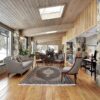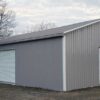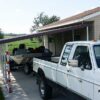Recyclable and Reusable
Steel is a durable product when in service, but when it is no longer in use, it can easily be reclaimed for use in another product or recycled into another steel product for further use.
The design of some steel truss buildings can also easily accommodate remodeling/retrofitting at a later date with minimum waste. This extends the sustainable life of the structure through rebirth or repurposing. With steel, the cradle-to-grave cycle can be avoided.
Non-Polluting
Steel components are stable, low emitting materials with little or no off-gassing. Therefore, they have indoor air quality benefits. Exposed structural steel eliminates the need for additional interior finishes which can be emitting and saves the energy and labor needed to extract, produce, install and dispose of the product.
Innovative
Steel is a strong and lightweight material. It does not shrink, swell or move with changes in the weather like conventional wood products. Steel is a strong light weight material, which can enhance the efficient use of other building material and products.
Low Maintenance
Steel trusses and steel siding require little or no maintenance once erected. Once again, the result is lower energy costs and expenses over the extended life of the building. With proper care, steel truss buildings (with steel siding) can far exceed the useful life of buildings with conventional structural wood construction.
Site Disruption
Where site conditions require or necessitate weight reduction, a steel structure can be the ideal solution. A steel building can be placed on piles thereby reducing site disturbances and help control and minimize erosion.
Responsible Manufacturing
Some manufacturing facilities recycle all of their steel scrap products so very little waste leaves the factory for the landfill.
Flexible Design
Steel buildings with a flexible design can easily and readily accommodate solar panels, geothermal heating and other innovate renewable energy technology.



